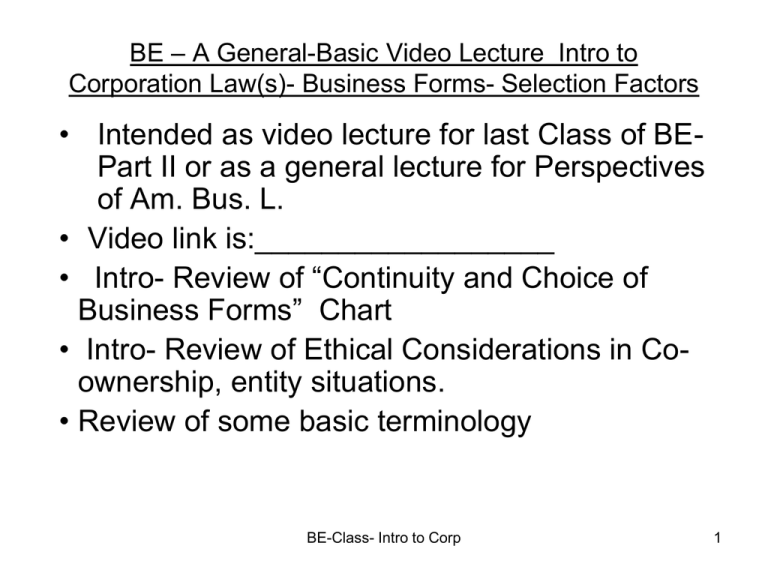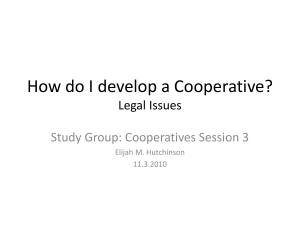Corporation
advertisement

BE – A General-Basic Video Lecture Intro to Corporation Law(s)- Business Forms- Selection Factors • Intended as video lecture for last Class of BEPart II or as a general lecture for Perspectives of Am. Bus. L. • Video link is:__________________ • Intro- Review of “Continuity and Choice of Business Forms” Chart • Intro- Review of Ethical Considerations in Coownership, entity situations. • Review of some basic terminology BE-Class- Intro to Corp 1 Intro. Cont’d • Intro- Historical Development(CB Ch 1 and Arner article on Twen), including recent/modern trends of corporation law • State Corporate Statutes - Basics • Internal Affairs Rule- Conflicts of Law-Case law • Basic Corporate Governing Structure • Rights & Protection of Owners • Statutory Gaps • Foreign Corporations BE-Class- Intro to Corp 2 Intro cont’d • The Processes- Pre-Formation, Formation, Post-Formation • Interplay of Statutes-Contracts-Case law • Importance of Structure/Planning: Allocation and Maintenance of Ownership and Managerial Control; Dispute Resolution; Exit Mechanisms • Corporate Taxation & Sec. Reg. Basics • Business Form Selection Factors BE-Class- Intro to Corp 3 Continuity and Choice of Business Forms entity v. non-entity legal rights & duties flows of liability statutory compliance taxation (federal & state) advantages and disadvantages of choice A. STATE LAW Unincorporated No State Action LTKs_____SP ____ Franchise Supply GP __ LP** Incorporated State Action State Action LLC ** _ Corp____________ JV LLP* -------LLLP* Bus Non-Profit Gen CHC Special Prof. Banks Ins. Corp. Agency Law * State filing ** state action ___________________________________________________________________ B. FEDERAL LAW: _____ Special – TVA (e.g.) SEC. Reg. (BE) - PHCE (34 Sec. Act) Tax - GP (Reporting, not taxable entity) Corp. – C Corp. (general) & Subch S (GP like) BE-Class- Intro to Corp 4 Basic Ethical Issues • Entity Representation/Client Identification (Sec 1.13of ABA Code) • Conflicts of Interest(ABA, Sec 1.7-1.8) • Scope of Representation/Engagement Letter (ABA 1.2) • Competency (ABA 1.1) • Confidentiality(ABA 1.6) • Fee Arrangements(ABA 1.5) BE-Class- Intro to Corp 5 BE- Clarification of certain terminology • In the past, for course and exam purposes, some confusion appears to arise for certain students as certain terminology being used . Hopefully, the following will help you avoid such confusion: • Business enterprise: generic term covering any form of sole ownership, co-ownership or long-term, cooperative business arrangement contemplating an ongoing business objective(s). Effectively would descriptively cover all the business forms covered in this course. Though “business enterprise” may have a specific meaning for economists, it has no specific legal content and is merely an umbrella, descriptive term. BE-Class- Intro to Corp 6 Terminology cont’d • Corporation- in this course, unless otherwise expressly indicated, a business entity formed under and subject to (for corporate law purposes) a state general corporation statute. Most states have separate special corporate-type statutes for Non-profit Corporations, Professional Corporations, Banking Corporations, and Insurance Companies. In addition as mentioned below, most states now has special statutory provisions under their corporation laws for electing to be a Statutory Close Corporation. • CHE (closely-held enterprise)- descriptively covers all forms of business enterprise formed under relevant state law that are coowned by a few owners , most (if not all) of whom are involved in the active management of the enterprise. BE-Class- Intro to Corp 7 Terminology cont’d • CHC (closely-held corporation)- descriptively covers all corporations formed under a general state business corporation statute that are co-owned by a few owners (shareholders/stockholders), most (if not all) of whom are involved in the active management of the corporation. • Close Corporation (statutory) - A corporation formed under a special state “Close Corporation statute” (e.g. Texas, Delaware etc.). BE-Class- Intro to Corp 8 Terminology cont’d • PHE (publicly-held enterprise) – Federal securities law status- any business enterprise formed under relevant state (e.g., corp., LP, business trust, LLC etc) whose ownership interests would come under the federal securities law definition of a “security” and which has a equity class of such securities registered under the ongoing registration/disclosure/and liability requirements of the 1934 Securities Exchange Act and subject to Securities Exchange Commission (SEC) scrutiny and enforcement. Normally, an enterprise with 500 or more owners and $10 million of more in assets. Still subject to the relevant state law(s) under which it was formed. BE-Class- Intro to Corp 9 Terminology cont’d • PHC (publicly-held corporation)- Federal securities law status-.a PHE that is formed as a corporation: the most common form of PHE. Still formed under and subject to relevant state corporation law. • “C Corp”- Tax Status- the Subchapter of the Internal Revenue Code under which most corporate entities or other business entities electing to be taxed as corporation would be subject. Tax as a separate entity/taxpayer. Double taxation situation. Still formed under and subject to relevant state corporation law. • “S or Subchapter S Corp”- Tax status- The Subchapter of the IRC under which a corporate taxpayer could elect special tax status so as to receive “partnership-like” income tax treatment. Still formed under and subject to relevant state corporation law. BE-Class- Intro to Corp 10 Theories of Corporation - Entity- Legal Person- Creature of State - Collection of Constituent Relationships - Contractarians- Nexus of Ks – Party Autonomy - Default Rules v. Mandatory Rules - Team Production Model - ? Role of Government Regulation outside of state corporate laws BE-Class- Intro to Corp 11 Consequences of Incorporation • Separate Legal Personality • Possibility of Centralized Management • Divisibility and Transferability of Ownership Interests- Ability to raise capital • Limited Liability for Owners (LtdL came later in 18th century: was not an original characteristic) BE-Class- Intro to Corp 12 Development of State Corporation Laws (including recent trends) • The historical beginnings in US -Distrust of Corporation and Corporate Power-Specific Charter Grants-Limited statutory powers-No holding companies) (parent-subs) • Rise of Enabling Statutes in mid 1800s • Late 19th century- start of code liberalization- The impact of Delaware Corp. Laws- ? “Race to the Bottom”- “Liggett v. Lee” • Separation of Ownership and Control-ImplicationsBerle; but today, can have large, influential institutional shldrs BE-Class- Intro to Corp 13 Development-Trends cont’d • The impact of Model Bus. Corp. Act (M.B.C.A & RMBCA); impact of Dela statute as a “national corporation law • Spread of other Ltd Liability Forms/Statutes (e.g. LLC) and flexibility within Corporate Codes ( e.g. RMBCA approach and Texas separate Statutory Close Corporation provision of Code)-Public Policy favoring small business person(s)-flexibility and party autonomy. • Reduction/elimination of role of statutory capital BE-Class- Intro to Corp 14 Development-Trends Cont’d • Judicial trend to apply partnership analogies to CHC • ? “Federal Corp. Law”- Fed Sec. Laws • Modern Day approaches on “Corporate Governance” for larger corp.- Pre and PostSOX • PHC v CHC • With modern LLC form, is there still a role for the business corporation BE-Class- Intro to Corp 15 What is a Corporation . . . .? Starting Point: State Statutes MBCA §§ 1.40 (4),2.02 & 2.03 DGCL §§ 102 & 106 BE-Class- Intro to Corp 16 Incorporation: An Event and a Process • Grant of the State: Creature of the State- Enabling Statute • Legal Entity(separate legal personality); Ltd. Liability for owners; Separate Ownership Instruments (transferability-ownership dispersion) • Ownership instruments & certain debt instruments – securities/securities laws • Statutory management/governance structure: centralized management v. owner management • Modern exception – statutory “close” corporations and RMBCA possible broad use of Shldr Agreement ( Sec 7.32) to structure internal management and governance including doing away with Bd. Of Ds . Some States (e.g. Texas and Dela.) also have special Statutory Close Corporation provisions • Incorporation- starting point for “allocating and maintaining control” (ownership and management), effective dispute resolution, exit BE-Class- Intro to Corp 17 Corporate Statutory Status • • • • • Corporation – General Special – e.g., banks, NPCs, PCs Hybrid – Stat. close corp. Subch S – Tax PHC – Sec. Law (not strictly speaking a corporate statute- investment securities statutes BE-Class- Intro to Corp 18 Basic Sources of Corporation “Laws” • State Enabling Statutes • Contract(s) • Case Law & Judicial Gloss- Gap-filling, Interpretation, Equity • ? Fed. and State Sec. Laws • Fed & State Tax Laws • ? Accounting Principles/Standards (including RAP for PHCs) BE-Class- Intro to Corp 19 Business Corporate Stat. Models MBCA RMBCA Dela. Gen. Corp. L. Hybrids (e.g., Texas) Special Close Corp. – Statutes (e.g, Texas and Delaware) BE-Class- Intro to Corp 20 Special Close Corp. Statutes Governance/Management OPTIONS} Traditional Partnership-like Hybrid BE-Class- Intro to Corp 21 Special Close Corp. Statutes 1. Share Restrictions 2. Compulsory Purchaser 3. Shareholder Agreements 4. Board Elimination 5. Elim. Bylaws 6. Special Dissolution and Dispute Resolution BE-Class- Intro to Corp 22 New Texas Business Organization Code (TBOC) http://tlo2.tlc.state.tx.us/statutes/bo.toc.htm • Spoke and Wheel Codified Consolidation Table of Contents TITLE 1. GENERAL PROVISIONS • CHAPTER 1. DEFINITIONS AND OTHER GENERAL PROVISIONS CHAPTER 2. PURPOSES AND POWER OF DOMESTIC ENTITY • CHAPTER 3. FORMATION AND GOVERNANCE • CHAPTER 4. FILINGS • CHAPTER 5. NAMES OF ENTITIES; REGISTERED AGENTS AND REGISTERED OFFICES • CHAPTER 6. MEETINGS AND VOTING FOR DOMESTIC ENTITIES • CHAPTER 7. LIABILITY • CHAPTER 8. INDEMNIFICATION AND INSURANCE • CHAPTER 9. FOREIGN ENTITIES • CHAPTER 10. MERGERS, INTEREST EXCHANGES, CONVERSIONS, AND SALES OF ASSETS • CHAPTER 11. WINDING UP AND TERMINATION OF DOMESTIC ENTITY CHAPTER 12. ADMINISTRATIVE POWERS BE-Class- Intro to Corp 23 TBOC- T of C cont’d TITLE 2. CORPORATIONS • CHAPTER 20. GENERAL PROVISIONS CHAPTER 21. FOR-PROFIT CORPORATIONS • CHAPTER 22. NONPROFIT CORPORATIONS CHAPTER 23. SPECIAL-PURPOSE CORPORATIONS TITLE 3. LIMITED LIABILITY COMPANIES • CHAPTER 101. LIMITED LIABILITY COMPANIES BE-Class- Intro to Corp 24 TBOC- T of C cont’d TITLE 4. PARTNERSHIPS • CHAPTER 151. GENERAL PROVISIONS • CHAPTER 152. GENERAL PARTNERSHIPS • CHAPTER 153. LIMITED PARTNERSHIPS CHAPTER • 154. PROVISIONS APPLICABLE TO BOTH GENERAL AND LIMITED PARTNERSHIPS TITLE 5. REAL ESTATE INVESTMENT TRUSTS • CHAPTER 200. REAL ESTATE INVESTMENT TRUSTS TITLE 6. ASSOCIATIONS • CHAPTER 251. COOPERATIVE ASSOCIATIONS • CHAPTER 252. UNINCORPORATED NONPROFIT ASSOCIATIONS TITLE 7. PROFESSIONAL ENTITIES • CHAPTER 301. PROVISIONS RELATING TO PROFESSIONAL ENTITIES • CHAPTER 302. PROVISIONS RELATING TO PROFESSIONAL ASSOCIATIONS • CHAPTER 303. PROVISIONS RELATING TO PROFESSIONAL CORPORATIONS CHAPTER 304. PROVISIONS RELATING TO PROFESSIONAL LIMITED LIABILITY COMPANIES TITLE 8. MISCELLANEOUS AND TRANSITION PROVISIONS • CHAPTER 401. GENERAL PROVISIONS • CHAPTER 402. MISCELLANEOUS AND TRANSITION PROVISIONS BE-Class- Intro to Corp 25 Corporate Governance Structure • Statutory Model v. Real Model • Position of Shareholders – – – – – – – – Ownership interest (including liquidation and any dividend rights) Voting rights Liquidation rights Inspection rights ? Dividend rights Litigation rights Derivative Litigation rights Appraisal rights-fundamental changes • Position of Directors • Position of Officers • Indemnification of Management • Special Close Corp. Provisions – “Partnership-like” BE-Class- Intro to Corp 26 Corporate Management – Decision-Making Levels Shldr - Director - Fundamental Matters Policy (Fiduciaries) Officers - Day-to-Day (Agents & Fiduciaries) BE-Class- Intro to Corp 27 Corp. – Management Structure Traditional Shareholders – Directors – Officers Non-Traditional CHC can approximate “partnership” no directors – “statutory close corp.” PHC – power in management BE-Class- Intro to Corp 28 Statutory Governance Model Shareholder----> Directors ----> Officers Legal Flow of Authority/Power ----> ? Reality = -----> Or <----? CHCs ? PHCs BE-Class- Intro to Corp 29 Rights/Protection of Shareholders-Owners • Equity Owners • Voting – directors and major changes • Preemptive rights: maintaining proportionate ownership interests • Cumulative voting - minority representation • Liquidation rights • Dividends (not mandatory) • Information – limited under state law broad if a P+C under Fed Sec. Law • Derivative Litigation • Case-law – particularly fiduciary duties and judicial gloss on freeze-out BE-Class- Intro to Corp 30 General Shareholder Voting • Requirement of State Law – Annual Meeting – Election of Directors – Meetings – Fundamental Changes • Management Initiate > Shareholder Contact • Practical Realities = Use of Proxies BE-Class- Intro to Corp 31 Statutory Gaps • In General – – – – – Conflicts of laws / fiduciary duties? Disclosure Special treatment of larger corporations Special treatment for CHCs Significance of legal status • Selected problem areas – Promoter problems – Disregard of corporate entity and limited liability shield – Relationship of controlling to minority shareholders BE-Class- Intro to Corp 32 Foreign Corporations • Internal Affairs Rules • Pseudo Foreign Corporation Laws • Qualification Statutes BE-Class- Intro to Corp 33 Importance of Structuring/Planning (see Building Block No. 6- Twen) • Basic allocation and maintenance of control issues (e.g., ownership interests; other financial interests; managerial control; exits, dispute resolutions) • Use of Articles, Bylaws, Share Instruments, Shareholder Ks etc • Tax Issues BE-Class- Intro to Corp 34 Redux- Legislative and Judicial Trends • Legislative- greater flexibility options; greater party autonomy; greater protection of limited liability shield. • Statutory “objectification” of fiduciary standards • Judicial- looking at CHC more as a “partnership”; greater protection in “shareholder oppression “ situations; judicially crafted remedies; exercise of its equity powers. Can vary among jurisdictions (e.g., compare Mass. V. Delaware) BE-Class- Intro to Corp 35 Corporation - Taxation • Separate taxpayer – separate tax schedule/rates • Subch C – IRC - standard • No Pass – thru (except with subch S); but often can “Zero-out” • “Double Taxation” (indiv. Shareholders) • §351 tax free incorporation • Cannot use “check-the-box” rules BE-Class- Intro to Corp 36 Tax Status-C Corp. v. S Corp • “C” corp.- usual – taxable entity- double taxation • “ S Corp.”- special tax status-partnership-like A Corporation under state law code But taxed similar to (but not exactly) as a partnership – modified conduct treatment Formal election; can be lost (serious adverse practical consequences-re-characterization for tax purposes as a C corp.) Max. of 100 individual shareholders (limited exception for estates of decedents and certain trusts). Most, though, are sole owner entities. No non-resident aliens One class stock (except can have common with different voting rights- no pfd stock). Can now have subsidiaries; No maximum asset size. All shareholders must consent in writing to election BE-Class- Intro to Corp 37 The Selection Process – General Considerations • The Players (owner, other financing sources including future investors and external sources, key employees) • Purposes and Objectives – Business – Non-Business • Financing Requirements • The Risks – Business & Legal • Basic Liability Issues • Basic Tax & Securities Concerns • Employee benefits • Advisers – Lawyers, Accountants, Fin. Planners • Basic Ethical Concerns • Time Frame • Costs BE-Class- Intro to Corp 38 Some Key Selection Factors- See Egan Article (Twen) • • • • • • • • • • • • Legal Restrictions & Burdens Limited Liability Tax Status- federal and state (e.g. Texas Margin/Franchise tax) Securities Status Informality v. Formality Simplicity v. Complexity Costs Flexibility – Double Edged Continuity of Life Centralization or Diffusion of Management Exit Options other than ownership interest Transferability of Ownership Interest; Concentration – Non-Transf. BE-Class- Intro to Corp 39 Characteristics of Alternative Forms of Business Organizations*- Hamilton Sole Proprietorship General Partnership Limited Partnership Limited Liability Company Formation No filing required. No filing required; agreement of parties involved. No permission required. Usually filing required to protect limited partners. Filing with state official required. Duration Sole Proprietor determines. Dissolved by Partner s death or bankruptcy. Same as general partnership. Sometimes limited by Perpetual. state law. Liability Sole Proprietor has unlimited liability. Partners have unlimited liability. General partners have Members not unlimited liability; typically liable for Limited partners debts of the LLC. limited to amount of investment. Shareholders are typically not personally liable for the debts of the corporation. Shareholders are typically not personally liable for the debts of the corporation. Simplicity of Operation Yes. Yes. Yes, but some formality related to limited partners. More formal than sole proprietorship, less formal than corporation. Formality of board of directors, officers, annual meetings, and annual reports. Formality of board of directors, officers, annual meetings, and annual reports. Management Sole Proprietor has full control of management and operations. Typically each partner General partners have has an equal voice control. unless otherwise arranged. Members have Operating Agreement that outlines management. The corporation is managed by or under the direction of the board of directors who are elected by the shareholders. The corporation is managed by or under the direction of the board of directors who are elected by the shareholders. Taxation Not a taxable entity. Sole proprietor pays all taxes. Not a taxable entity. Income or loss is passed through to partners. Not a taxable entity. Income or loss is passed through to partners. Members may choose whether to have LLC be a taxable entity or to have income or loss passed through to members. Not a taxable entity. Income or loss is passed through to the shareholders. Corporation is a taxable entity. Double Taxation No. No. No. No. No. Yes. Cost of Formation None. None. May be filing fee. State filing fee. State filing fee. State filing fee. Raising Equity Capital Not unless individual puts in money. Contributions from partners or an addition of more partners. Same as a General Partnership. Possible to sell interest. Subject to operating agreement. Sell shares of stock to Sell shares of stock to raise capital. raise capital. Transferability of Interest No. No. Some for limited partners. Possibly. Yes, subject to consent. BE-Class- Intro to Corp S-Corporation Filing with state official required. Corporation Filing with state official required. Perpetual. Shares of stock are easily transferable. 40 Bromberg – Comparison of Business Forms Characteristics* LLP LLC Corp. LP** Must be subject to federal corporate tax No No Yes No May be used by professional Yes Yes Yes1 No May be used by nonprofit firms No Some Yes2 No May be used by one-member firms No Yes3 Yes No Owners have limited liability for all debts of firm Some Yes Yes No4 Insurance requirement Some No Some5 No Distribution restrictions Some Yes Yes Yes Decisions-making formalities No No Yes No Centralization of decision-making power No Yes Yes Yes Firm necessarily dissolves on member dissociation Some6 No No No Default buyout right Yes Some No Some Federal Securities law apply ? ? Yes Yes State securities laws apply ? Some Yes Yes Convert or register from other business form Yes7 Some Some Some8 Formation state law governs Yes Yes Yes Yes BE-Class- Intro to Corp 41 Notes to Bromberg Chart * Refers to characteristic determined wholly or mostly by governing business association statutes. ** Some of these features, notably including partners’ liability, default buyout rights, and conversion, may be changed by Re-RU.L.P.A. Remember State Margin/Franchise Tax Applicatility Yes=Applies to firms governed by most or all status. No=Does not apply to firms governed by some statues. ?=Application of feature is unsettled or varies from state to state. BE-Class- Intro to Corp 42 Further Notes to Bromberg Chart 1. 2. 3. 4. 5. 6. Applies under professional corporate statutes. Applies under nonprofit corporate statutes. All but Massachusetts. Does not apply to limited partners or to LLLPs. Applies to professional corporations. Applies under U.P.A.-based but not R.U.P.Abased statutes. 7. Registration by existing general or limited partnerships. 8. R.U.P.A. permits conversion from general partnership. BE-Class- Intro to Corp 43






